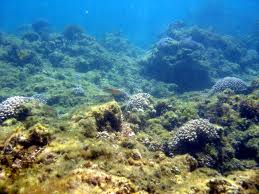In the past two centuries, there has been an increase in industrial and agricultural activities of humans and large advancements in technology which while creating progress for mankind have led to the release of exorbitant amounts of carbon dioxide into the atmosphere. This has created environmental problems and caused global climate change. Oceans absorbing it have benefited us by slowing climate change, and we rejoiced because of it until it was discovered recently that this process, known as ocean acidification had a downside too.
Ocean acidification is thus named because the carbon dioxide absorbed gets converted in the water to carbonic acid, consequentially decreasing the pH of the ocean water. The acidity or alkalinity of a medium is measured on a pH scale ranging from 0 to 14, with 14 being strongly basic and acidity increasing with the decrease in pH number, 7 indicating neutral. Between 1751 and 1994 surface ocean pH is estimated to have decreased from approximately 8.25 to 8.14, especially at the ocean surface. By the end of this century, it is predicted to drop further by 0.5.
One third of the human emission of carbon dioxide is absorbed by the world’s oceans i.e. about 22 million tons a day. While this helps to mitigate the climatic effect of the carbon dioxide, it has negative consequences for marine life. A large range of marine organisms such as corals, oysters, shrimp, lobster, many planktonic organisms, and even some fish species undergo the process of calcification to form shells, but the elevated presence of carbonate and carbonic acid in the ocean waters have reduced the rate of calcification in these animals or increased the rate of dissolution of their calcareous shells.
Aside from this, ocean acidification can depress metabolic rates in jumbo squid and the immune responses of blue mussels, and cause coral bleaching. Many different marine species are affected by the harmful effects of increasing acidity. Unless carbon emission is controlled or reduced, marine life will have to adapt to the changing chemistry of the ocean or perish. The decrease in the pH of the ocean affects life cycle of many marine species especially those at the bottom of the food chain.
Because most of the calcifying organisms form the base of the food cycle, their reduction in population due to ocean acidification can result in a serious decline in commercial fisheries. Arctic tourism depends heavily on the sport fishing and hunting industry, both of which are endangered due to the collapsing food webs. Fish population has significantly declined due to acidification; it is not just a threat.
Awareness about ocean acidification is still fresh and scientists are yet to carefully study each aspect of this phenomenon. However, many solutions have been proposed.
The primary and most obvious answer is to reduce the anthropogenic carbon dioxide (CO2 produced by humans). This can be done by lowering the emission of greenhouse gases. All individuals can work on reducing their personal carbon footprint. Climate engineering and nutrient loading are other possible responses to the problem, although nutrient loading is only a short-term solution, and the WGBU, UK’s Royal Society and the US National Research Council have all released reports indicating that nutrient loading is not feasible; it is expensive, will be only partly effective and could have many ecological side effects that we cannot predict.
Yet another approach could be iron fertilisation, a process in which finely ground iron is added to the water that stimulates photosynthesis in phytoplankton. Experiments conducted near the Galapagos Islands have shown an increase in the rate of photosynthesis of plankton after the addition of iron, but there are fears that mitigating the surface acidification of the ocean might result in acidification of the less-inhabited deep ocean. Producing the finely ground iron, dispersing it into the sea and increasing its shelf-life are some of the problems faced by scientists trying this method. Additionally, the excess oxygen emanated due to the increased photosynthesis can lead to the blooming of algae that may suffocate various species of fish.
Bony fishes contribute to the alkalization of oceans. It is possible to genetically engineer bony fish and other certain species to improve alkalization of ocean water or introduce new policies that can boost the population of the bony fishes. Shellfish growers over the world are struggling to keep their livelihoods. Shellfish including molluscs and scallops are soon going to be hard to come by for ocean wildlife and are becoming rarer on people’s dinner plates.

Leave a Reply